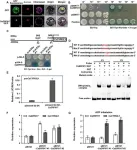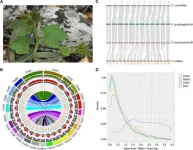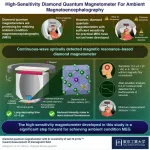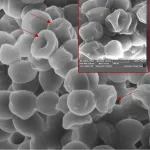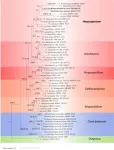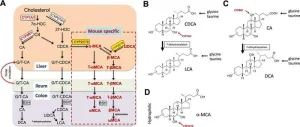(Press-News.org) Two independent studies by Columbia scientists suggest that research into the gut’s stem cells over the past 15 years has been marred by a case of mistaken identity: Scientists have been studying the wrong cell.
Both studies were published online today in the journal Cell.
The gut’s stem cells are some of the hardest-working stem cells in the body. They work continuously throughout our lives to replenish the short-lived cells that line our intestines. About every four days, these cells—covering a surface about the size of a tennis court—are completely replaced.
Understanding these workaholic stem cells could help scientists turn on less productive stem cells in other organs to repair hearts, lungs, brains, and more.
The gut’s stem cells were supposedly identified more than 15 years ago in a landmark study.
But using new lineage tracing and computational tools, the Columbia teams, led by Timothy Wang and Kelley Yan, found that these cells are descendants of the gut’s true stem cells. The gut’s true stem cells are found in a different location, produce different proteins, and respond to different signals.
“The new work is controversial and paradigm-shifting but could revitalize the [entire?] field of regenerative medicine,” says Timothy Wang, the Dorothy L. and Daniel H. Silberberg Professor of Medicine.
“We know we're making a lot of waves in the field, but if we're going to make progress, we need to identify the true stem cells so we can target these cells for therapies,” says Kelley Yan, the Herbert Irving Assistant Professor of Medicine.
We recently spoke with Yan and Wang about the findings and implications.
Why does the gut need stem cells?
KY What's relevant to this story is a tissue called the intestinal epithelium. This is a single layer of cells that lines the gut and it’s composed of different types of cells that help digest food, absorb nutrients, and fight microbes.
Most of the cells live for only about four days before being replaced, so stem cells must create replacements.
What's really remarkable about the intestinal lining is how big it is. If we were to fillet open your intestine and lay it flat, it would cover the surface of a tennis court.
The gut’s stem cells may be the hardest working stem cells in the body.
The gut’s stem cells were supposedly identified in 2007, and the discovery was hailed as a breakthrough in stem cell science. What made you think this was a case of mistaken identity?
TW: For the last 17 years, the intestinal stem cell field has assumed that Lgr5, a protein on the cell’s surface, is a specific marker for intestinal stem cells. In other words, all Lgr5+ cells are assumed to be stem cells, and all stem cells are believed to be Lgr5+. These Lgr5+ cells were located at the very bottom of glands, or crypts, in the intestinal lining.
However, in the last decade, problems with this model began to appear. Deleting the Lgr5+ cells in mice, using a genetic approach, did not seem to bother the intestine very much, and the Lgr5+ stem cells reappeared over the course of a week. In addition, the intestine was able to regenerate after severe injury, such as radiation-induced damage, even though the injury destroyed nearly all Lgr5+ cells.
KY: By their very definition, stem cells are the cells that regenerate tissues, so these findings created a paradox. Many high-profile papers have evoked different mechanisms to explain the paradox: Some suggest that other fully mature intestinal cells can walk backward in developmental time and regain stem cell characteristics. Others suggest there's a dormant population of stem cells that only works when the lining is damaged.
No one has really examined the idea that maybe the Lgr5+ cells really aren't truly stem cells, which is the simplest explanation.
How did your labs identify the gut’s real stem cells?
TW: My lab collaborated with the former chair of Columbia’s systems biology department, Andrea Califano, who has developed cutting-edge computational algorithms that can reconstruct the relationships among cells within a tissue. We used single-cell RNA sequencing to characterize all the cells in the crypts, the region of the intestine where the stem cells are known to reside, and then fed that data into the algorithms.
These algorithms revealed the source of “stemness” in the intestine not in the Lgr5+ cellular pool but in another type of cell higher up in the crypts in a region known as the isthmus. After eliminating Lgr5+ cells with radiation or genetic ablation, we confirmed these isthmus cells were the gut’s stem cells and able to regenerate the intestinal lining. We didn’t find any evidence that other, mature cells could turn back time and become stem cells.
KY: We weren’t trying to identify the stem cells as much as we were trying to understand the other cells in the intestine involved in regeneration of the lining. No one has been able to define these other progenitor cells in the intestine.
We identified a population of cells that were proliferative and marked by a protein called FGFBP1. When we asked how these cells were related to Lgr5+ cells, our computational analysis told us that these FGFBP1 cells give rise to all the intestinal cells, including Lgr5+, the opposite of the accepted model.
My graduate student, Claudia Capdevila, then made a mouse that would allow us to determine which cells—Lgr5+ or FGFBP1+—were the true stem cells. In this mouse, every time the FGFBP1 gene is turned on in a cell, the cell would express two different fluorescent proteins, red and blue. The red would turn on immediately and turn off immediately, while the blue came on a little later and lingered for days.
That allowed us to track the cells over time, and it clearly showed that the FGFBP1 cells create the Lgr5+ cells, the opposite of what people currently believe. This technique, called time-resolved fate mapping, has only been used a few times before, and getting it to work was a pretty incredible achievement, I thought.
How will this affect the stem cell field and the search for stem cell therapies?
TW: This case of mistaken identity may explain why regenerative medicine has not lived up to its promise. We’ve been looking at the wrong cells.
Past studies will need to be reinterpreted in light of the stem cells’ new identity, but eventually it may lead to therapies that help the intestine regenerate in people with intestinal diseases and possible transplantation of stem cells in the future.
KY: Ultimately, we hope to identify a universal pathway that underlies how stem cells work, so we can then apply the principles we learn about the gut to other tissues like skin, hair, brain, heart, lung, kidney, liver, etc.
It's also thought that some cancers arise from stem cells that have gone awry. So, in understanding the identity of the stem cell, we might be able to also develop novel therapeutics that can prevent the development of cancer.
That’s why it's so critical to understand what cell underlies all of this.
Additional information
“Time-resolved fate mapping identifies the intestinal upper crypt zone as an origin of Lgr5+ crypt base columnar cells,” was published June 6 in Cell.
All authors: Claudia Capdevila, Jonathan Miller, Liang Cheng, Adam Kornberg, Joel J. George, Hyeonjeong Lee, Theo Botella, Christine S. Moon, John W. Murray, Stephanie Lam, Ermanno Malagola, Gary Whelan, Chyuan-Sheng Lin, Arnold Han, Timothy C. Wang, Peter A. Sims, & Kelley S. Yan. The authors (all from Columbia) declare no competing financial interests.
The study was supported by the U.S. National Institutes of Health (though grants DP2DK128801, R01AG067014, P30CA013696, P30DK132710, U01DK103155, T32DK083256, and T32HL105323), a Burroughs Wellcome Fund Career Award for Medical Scientists, the Irma T. Hirschl Trust, an Irving Scholars Award, the Gerstner Foundation, a Damon Runyon-Rachleff Innovation Award, a NYSTEM predoctoral training grant, and the Berrie Foundation.
“Isthmus progenitor cells contribute to homeostatic cellular turnover and support regeneration following intestinal injury,” was published June 6 in Cell.
All authors (from Columbia unless noted): Ermanno Malagola, Alessandro Vasciaveo, Yosuke Ochiai, Woosook Kim, Biyun Zheng (Columbia and Fujian Medical University, China), Luca Zanella, Alexander L.E. Wang, Moritz Middelhoff (University Hospital Heidelberg), Henrik Nienhüser (University Hospital Heidelberg), Lu Deng (University of Kansas), Feijing Wu, Quin T. Waterbury, Bryana Belin, Jonathan LaBella, Leah B. Zamechek, Melissa H. Wong (Oregon Health & Sciences University), Linheng Li (University of Kansas), Chandan Guha (Albert Einstein College of Medicine), Chia-Wei Cheng, Kelley S. Yan, Andrea Califano (Columbia and Chan Zuckerberg Biohub NY), and Timothy C. Wang.
This research was funded by the U.S. National Institutes of Health (through grants P30CA013696, P30DK132710, U01DK103155, R35CA210088, R01NK128195, R35CA197745, S10OD012351, S10OD021764, and S10OD032433) and the U.S. Department of Defense (grants W81XWH-465 21-10901 and W81XWH19-1-0337).
Andrea Califano is founder, equity holder, and consultant of DarwinHealth Inc., a company that has licensed from Columbia University some of the algorithms used in this manuscript. Columbia University is also an equity holder in DarwinHealth Inc. U.S. patent number 10,790,040 has been awarded related to this work, assigned to Columbia University with Andrea Califano as an inventor.
END
The gut’s stem cells get a new identity
2024-06-06
ELSE PRESS RELEASES FROM THIS DATE:
The World Cultural Council (WCC) is pleased to announce the names of the 2024 Awards
2024-06-06
SCIENCE
Professor Eske Willerslev, Professor of Evolutionary Biology at the University of Copenhagen and Prince Philip Professor at the University of Cambridge, has been selected as the winner of the Albert Einstein World Award of Science 2024.
The prize is granted in recognition of the numerous breakthroughs in evolutionary genetics Prof. Willerslev’s has made during his highly fruitful career. The award recognizes his pioneering contributions in establishing the field of Environmental DNA and the sequencing of ancient DNA to track the origins and interactions of human population groups.
During his doctoral studies, Prof. Willerslev published ...
Citrus saviors: discovering the genetic defense against Huanglongbing disease
2024-06-06
A recent study has pinpointed two key enzymes in Citrus sinensis that play a crucial role in the plant's defense mechanism against the Asian citrus psyllid (ACP), a vector for the lethal huanglongbing (HLB) disease. This research offers a promising lead in the battle against a disease that has caused significant losses in the citrus industry.
The citrus industry faces major challenges from Huanglongbing (HLB) disease, transmitted by the Asian citrus psyllid (ACP). Traditional control methods are often ineffective and environmentally harmful. The need for innovative and sustainable pest management strategies is ...
Desert hero unveiled: Cissus quadrangularis genome decodes drought survival tactics
2024-06-06
In a recent study, scientists have unlocked the genetic secrets of Cissus quadrangularis, a plant that flourishes in the harshest of desert climates. The discovery of its adaptive traits and the Crassulacean acid metabolism (CAM) pathway marks a significant leap forward in the quest for drought-resistant crops.
As water scarcity looms as a major threat to global ecosystems and food production, the quest to understand how plants like Cissus quadrangularis conquer arid landscapes is more critical than ever. The genetic blueprint of such species could hold the key to enhancing ...
Afib patients on low doses of blood thinners have more bleeding episodes than those on standard doses
2024-06-06
(WASHINGTON, June 6, 2024) – Patients with atrial fibrillation (Afib) who took low doses of blood-thinning medications known as direct oral anticoagulants (DOACs) experienced more bleeding episodes during the first three months of treatment and about one in five had high blood levels of the medications, compared with similar patients who took standard doses of the same medications, according to a study published in Blood Advances.
Patients with Afib, a common type of arrhythmia, or ...
Severity of calls to US poison centers increases sharply for both adults, kids
2024-06-06
America’s poison centers are fielding increasingly severe cases that are dramatically more likely to lead to severe harm or death in both adults and children, a new study from the University of Virginia School of Medicine reveals.
The number of calls about intentional exposures that resulted in death among adults increased a whopping 233.9% between the beginning of 2007 and the end of 2021, the study reveals. “Intentional exposures” include cases such as suicide attempts, use of illegal drugs and ...
Novel diamond quantum magnetometer for ambient condition magnetoencephalography
2024-06-06
Magnetoencephalography (MEG) is a biomedical imaging technique used for mapping brain activity by recording magnetic fields produced by the naturally occurring electrical currents generated by neurons in the brain, using very sensitive magnetometers. Currently, MEG requires a magnetically shielded room for operation. Achieving MEG that works in normal environments, without the need for magnetic shielding, is a major goal. This would enable daily diagnosis, brain-machine interfaces, and fundamental research on brain function.
Magnetometers using diamond quantum sensors with nitrogen–vacancy (NV) centers are promising candidates for realizing ambient ...
Novel lipopeptide proves lethal against Staphylococcus areus
2024-06-06
A novel antibacterial lipopeptide produced by the bacterium Serratia marcescens has been shown to be highly effective in killing Staphylococcus aureus – one of the most important pathogens occurring in humans.
Staphylococcus aureus is one of the five most common causes of hospital-acquired infections and is often the cause of life-threatening infections following surgery. Since the introduction of antibiotics in the early 1940s, S. aureus has by now developed resistance against most classes of antibiotics, ...
Harposporium incensis sp. nov., a South American cordycipitoid species exhibiting inter-phylum host-jumping and having potential as a biological control agent for pest management
2024-06-06
The genus of Harposporium belongs to the Ascomycota of the Fungi kingdom, the class Sortariomycetes, the order Hypocreales, and the family Ophiocordyceiaceae, is a common genus of soil fungi. The species of Harposporium are pathogens of nematodes, with some also infecting rotifers or tardigrades, and has significant ecological value. In recent years, studies have shown that a few species of the genus Harposporium can also parasitize insects or other invertebrates, such as H. janus, which can infect beetles in the Coleoptera family. However, so far, it has not been found that the same species in this genus can parasitize different invertebrates in both sexual and asexual stages. Is there a ...
Balancing act between digestion and liver health through bile acids
2024-06-06
Bile acids are essential molecules the liver produces that play a critical role in digestion. They help us absorb fat-soluble vitamins and cholesterol from our food. However, bile acids can become a double-edged sword. While they are necessary for proper digestion, high concentrations can also be toxic to the liver.
Recent research is shedding light on the complex relationship between bile acids and liver health. Scientists have identified new ways in which bile acids interact with cellular stress responses, impacting how the liver functions in diseases ...
Cleveland clinic-led study links sugar substitute to increased risk of heart attack and stroke
2024-06-06
June 6, 2024, Cleveland: Cleveland Clinic researchers found higher amounts of the sugar alcohol xylitol are associated with increased risk of cardiovascular events like heart attack and stroke.
The team, led by Stanley Hazen, M.D., Ph.D., confirmed the association in a large-scale patient analysis, preclinical research models and a clinical intervention study. Findings were published today in the European Heart Journal.
Xylitol is a common sugar substitute used in sugar-free candy, gums, baked ...

